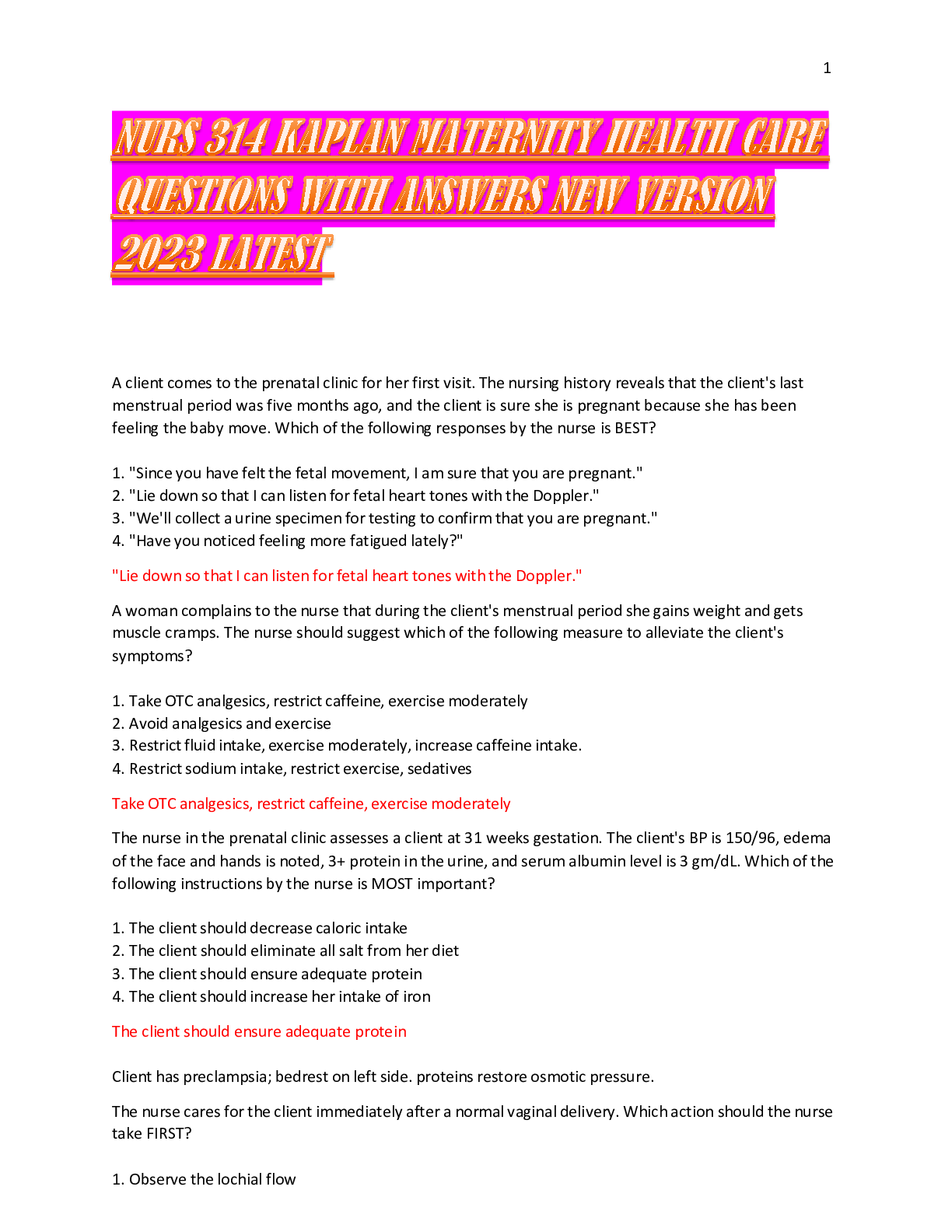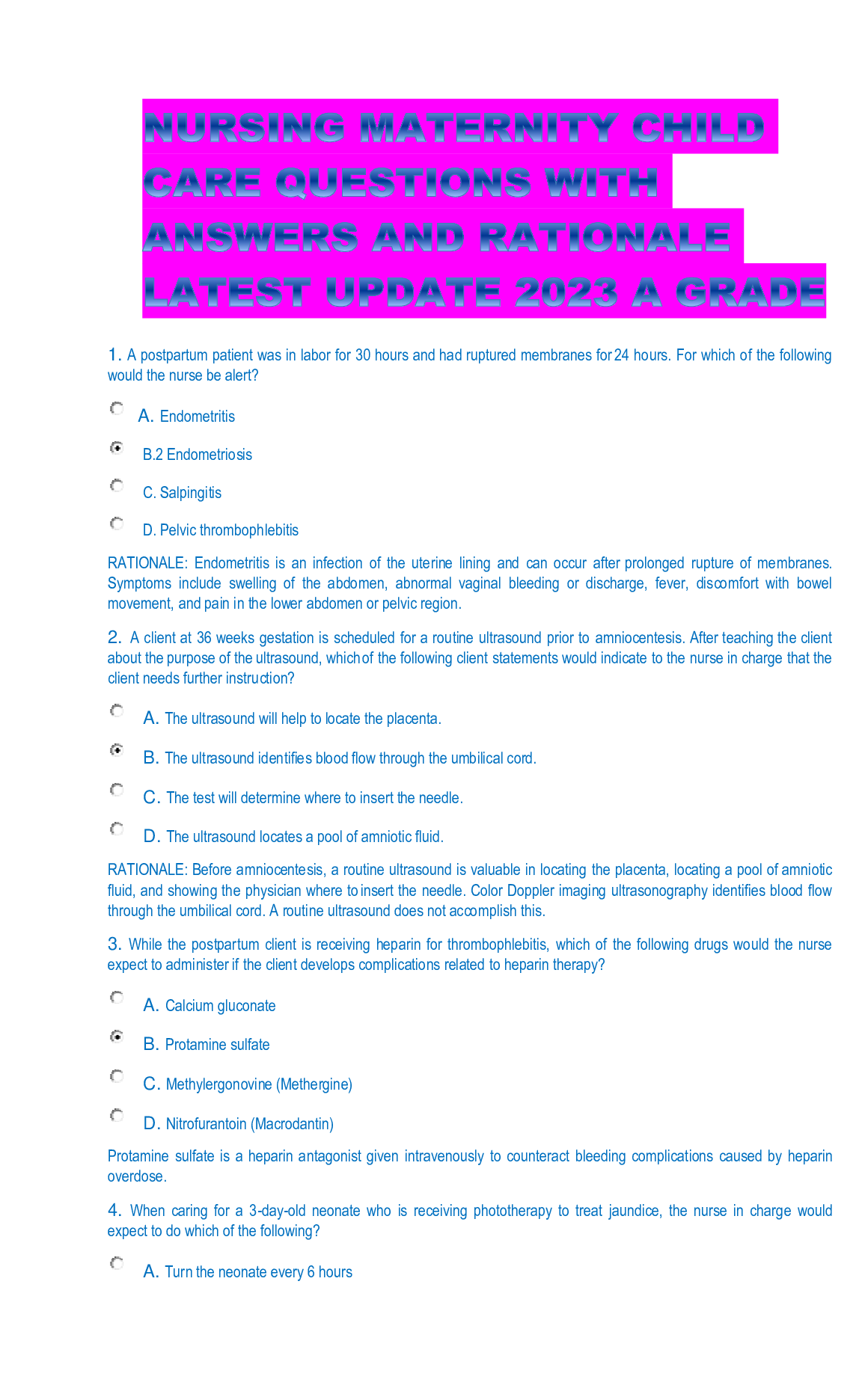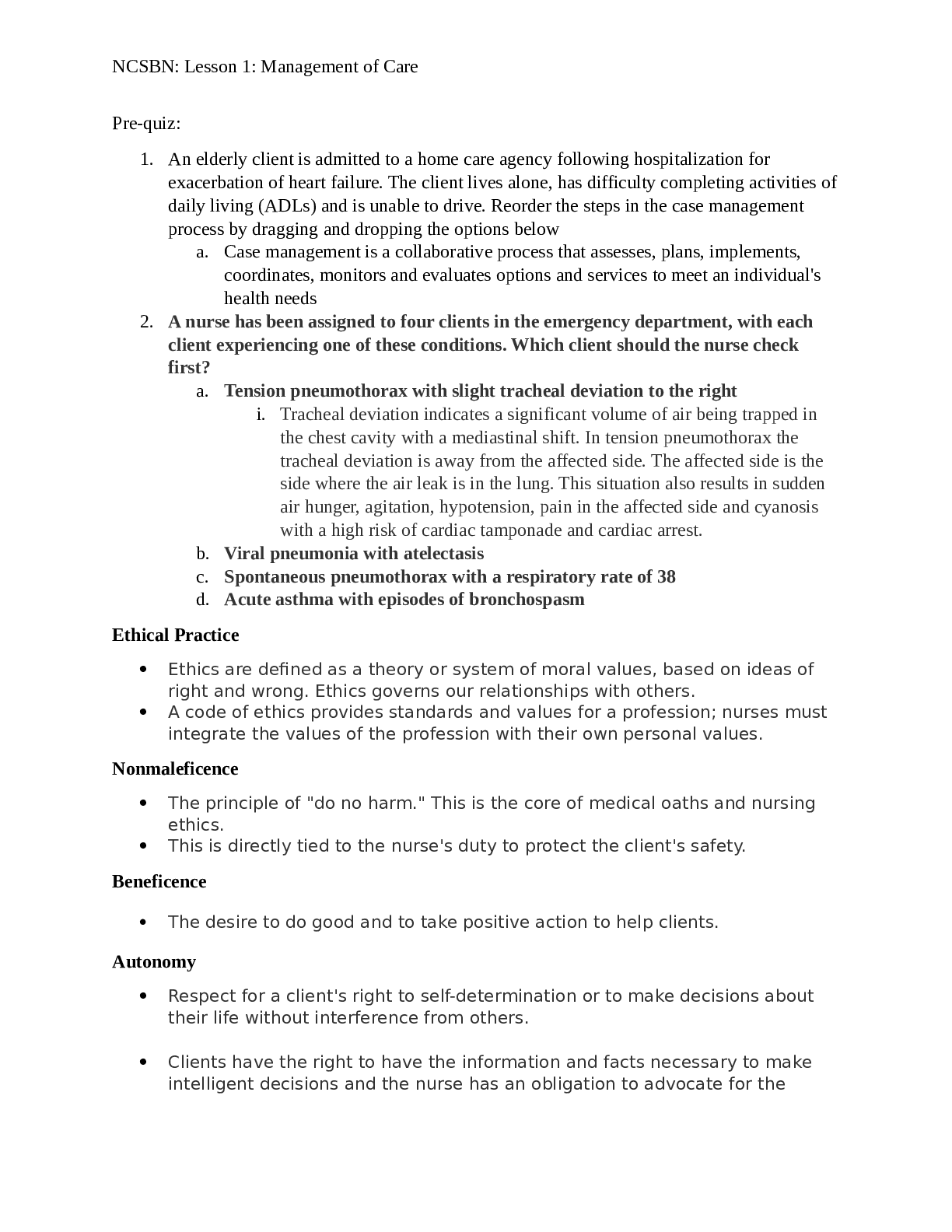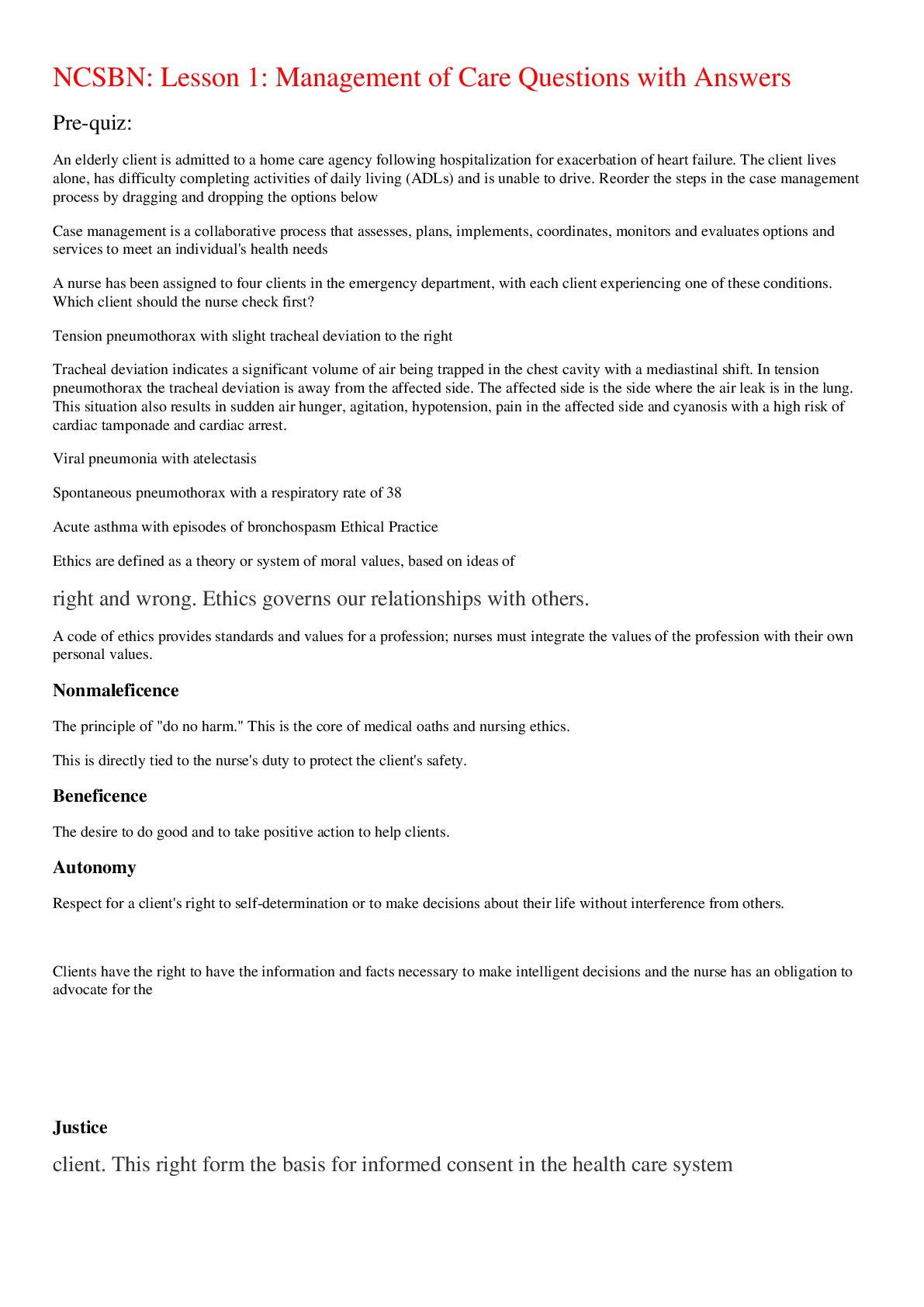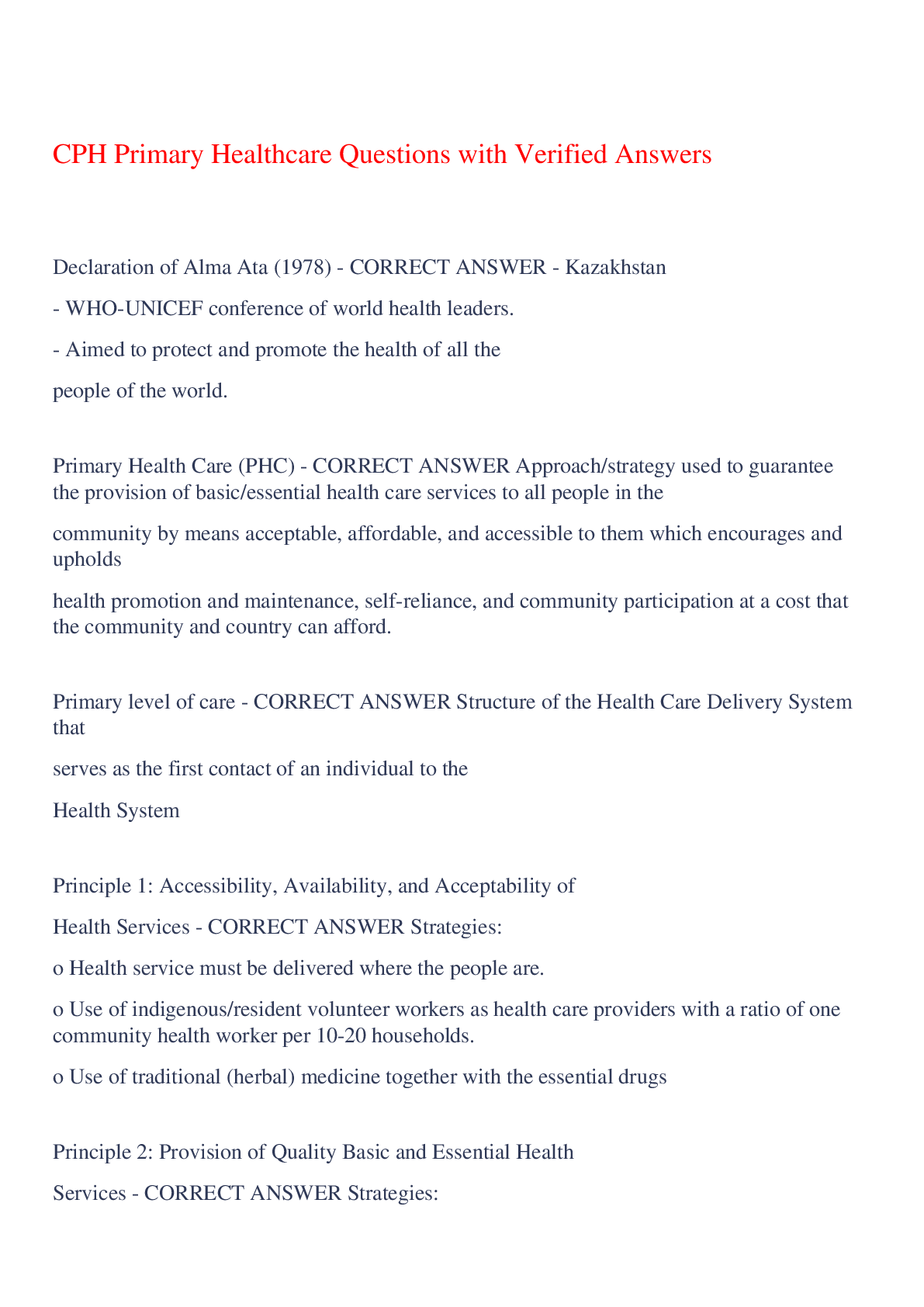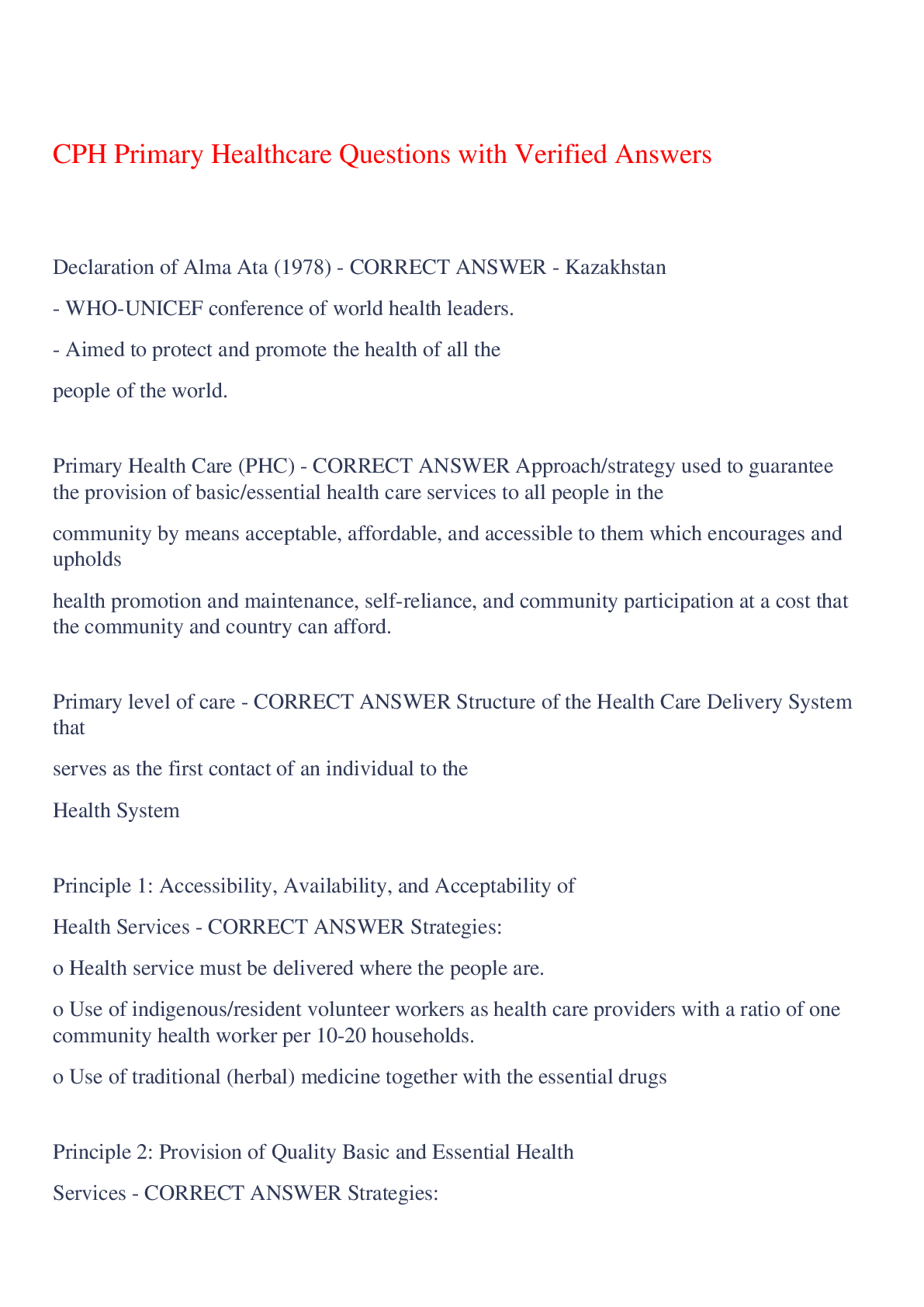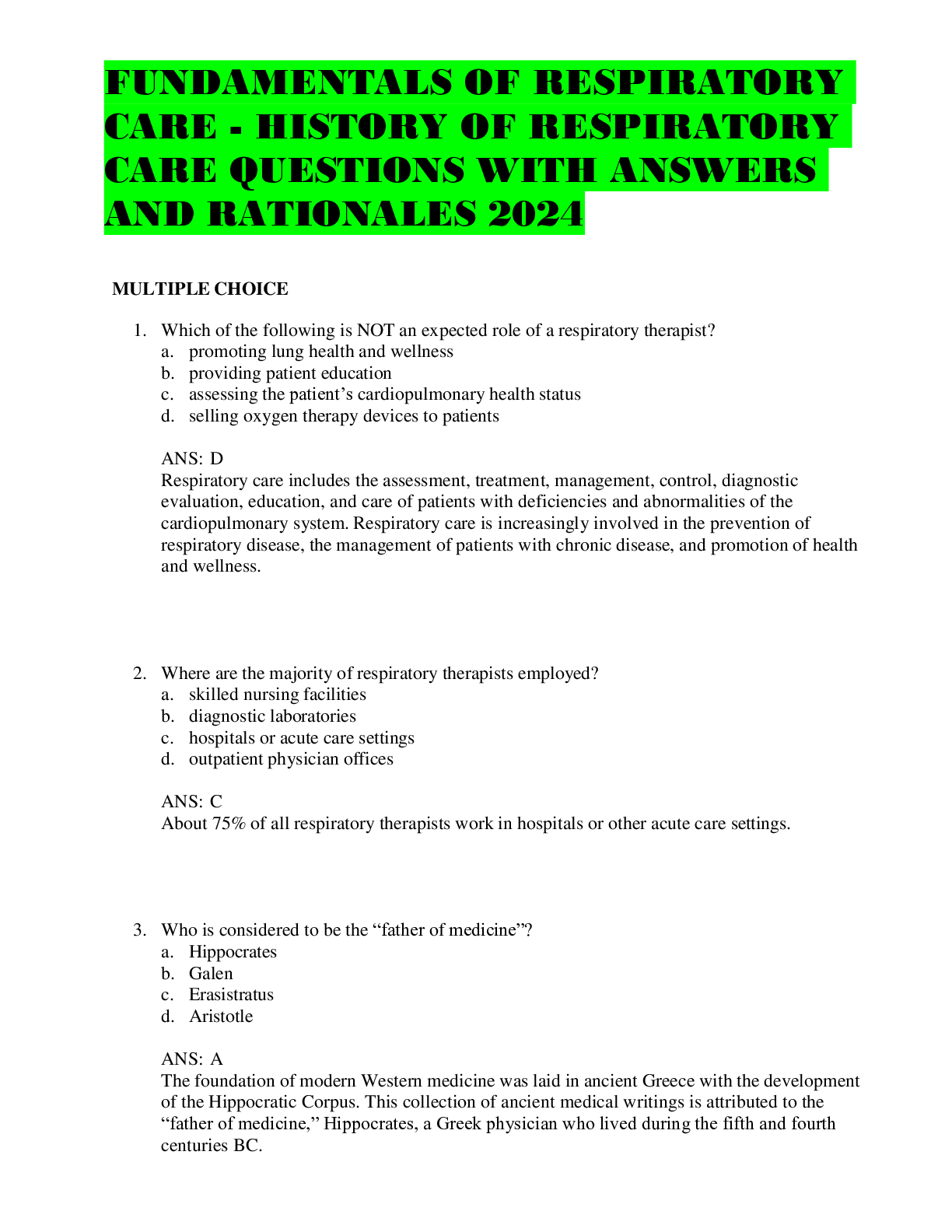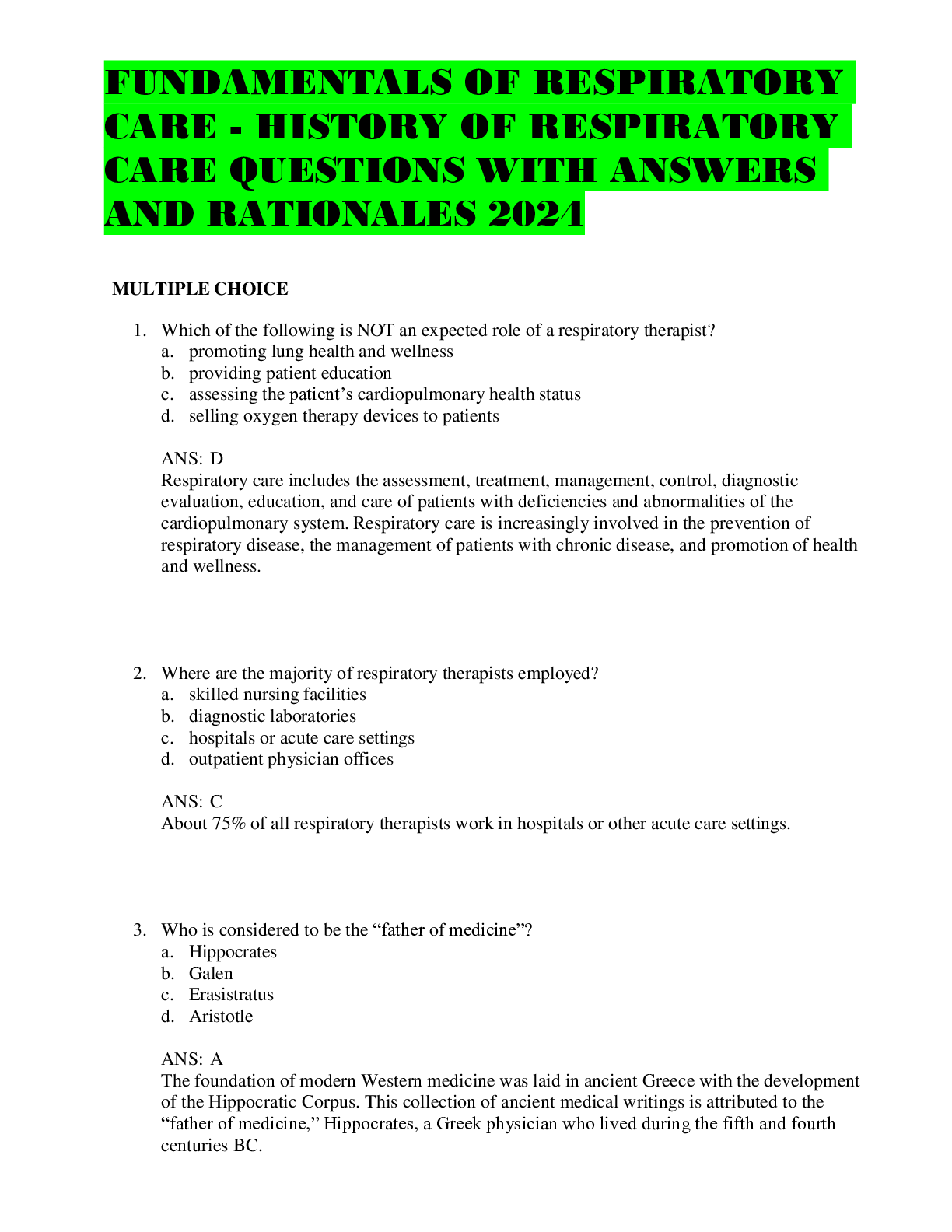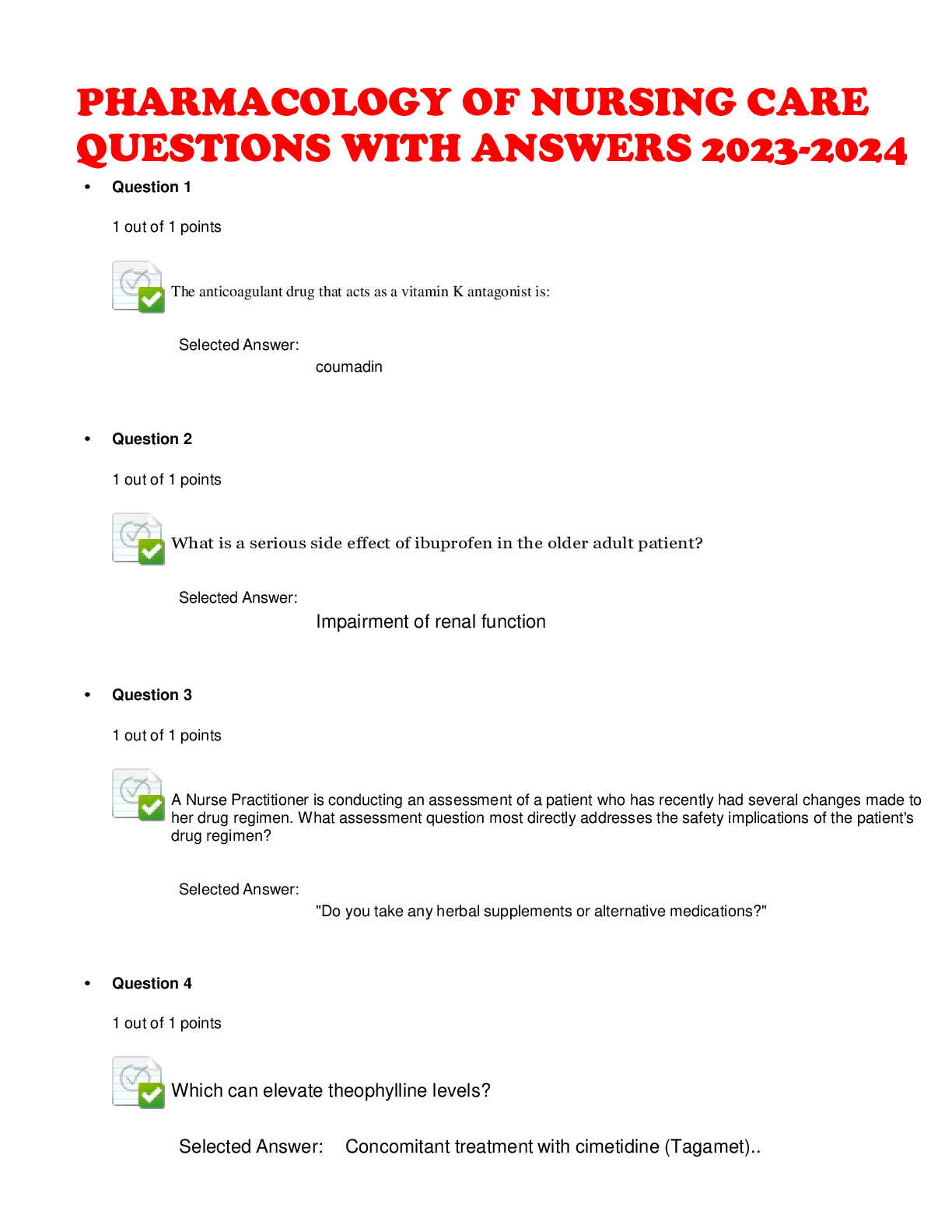NCSBN: Lesson 1: Management of Care Questions with Answers,100% CORRECT
Document Content and Description Below
NCSBN: Lesson 1: Management of Care Questions with Answers Pre-quiz: 1. An elderly client is admitted to a home care agency following hospitalization for exacerbation of heart failure. The client ... lives alone, has difficulty completing activities of daily living (ADLs) and is unable to drive. Reorder the steps in the case management process by dragging and dropping the options below a. Case management is a collaborative process that assesses, plans, implements, coordinates, monitors and evaluates options and services to meet an individual's health needs 2. A nurse has been assigned to four clients in the emergency department, with each client experiencing one of these conditions. Which client should the nurse check first? a. Tension pneumothorax with slight tracheal deviation to the right i. Tracheal deviation indicates a significant volume of air being trapped in the chest cavity with a mediastinal shift. In tension pneumothorax the tracheal deviation is away from the affected side. The affected side is the side where the air leak is in the lung. This situation also results in sudden air hunger, agitation, hypotension, pain in the affected side and cyanosis with a high risk of cardiac tamponade and cardiac arrest. b. Viral pneumonia with atelectasis c. Spontaneous pneumothorax with a respiratory rate of 38 d. Acute asthma with episodes of bronchospasm Ethical Practice • Ethics are defined as a theory or system of moral values, based on ideas of right and wrong. Ethics governs our relationships with others. • A code of ethics provides standards and values for a profession; nurses must integrate the values of the profession with their own personal values. Nonmaleficence • The principle of "do no harm." This is the core of medical oaths and nursing ethics. • This is directly tied to the nurse's duty to protect the client's safety. Beneficence • The desire to do good and to take positive action to help clients. Autonomy • Respect for a client's right to self-determination or to make decisions about their life without interference from others. • Clients have the right to have the information and facts necessary to make intelligent decisions and the nurse has an obligation to advocate for the Justice client. This right form the basis for informed consent in the health care system • The principle of fairness and equality for all clients Privacy and Confidentiality • Privacy belongs to a client and cannot be taken away unless they wish to share it. Confidentiality • The right to expect that information will be kept private or secret and shared on a need-to-know basis only. • means that the information shared with other persons will be used for intended purposes only. • Clients have a right to have personal information kept confidential and distributed only to authorized personnel per the Health Insurance Portability and Accountability Act (HIPPA). It is necessary to obtain the client's permission to release information to family members or friends Fidelity • This principle involves loyalty, faithfulness, truthfulness and honoring commitments. Nurses must always advocate for and honor their clients' wishes. • Fidelity is based upon the virtue of caring Client’s Rights Clients have the rights to: Be informed of their treatment options Accept treatment options or refuse treatment, even life-sustaining treatments Advance Directives • A legal document (such as a living will) signed by a living competent person in order to provide guidance for medical and health-care decisions (e.g., the termination of life support and organ donation) in the event that the person becomes unable to make such decisions. • is a written statement of a person's wishes regarding medical treatment. It often includes a living will (spells out your end of life car wishes) and identifies a durable power of attorney for health care (also called medical power of attorney, health care agent or health care proxy). • Advance directives do not expire. However, one state's advance directive does not always work in another state • Durable Power of Attorney for Health Care (DPAHC) is a document that lets clients name someone else (the health care "agent" or "proxy") to make health care decisions in case they are not able to make those decisions. • The agent can make decisions about the client's care, such as when to admit or discharge the client, the types of treatments or medications the client can receive. The agent also has access to all health care records o Types of AD ▪ Health Care Power of Attorney ▪ Living Will ▪ DNR ▪ POLST (Physician Orders for Life-Sustaining Treatments) DNR • Do not resuscitate (DNR) is a medical order, usually written by a physician. It instructs health care providers not to perform cardiopulmonary resuscitation (CPR) if a client's breathing stops or if the client's heart stops beating. The DNR order may also include identification of medications that may be given without any defibrillation attempts. • The client or health care proxy can withdraw the order at any time AND • Allow natural death (AND) is a medical term limiting or prohibiting the use of life-extending measures. • This order acknowledges that the client is dying and everything that is being done for the client, including the withdrawal of nutrition and hydration, will allow the dying process to occur as comfortably as possible Organ Donation • Nurses advocate for and support families throughout the organ and tissue donation process. • Nurses involved in the process of organ and tissue donation should be knowledgeable of the ethical, cultural, religious and social issues related to organ and tissue donation Informed Consent • A client's consent to surgery or a subject's consent to participation in a medical experiment, after achieving an understanding of what is involved. • grants permission to perform a test or procedure. The health care provider is legally obligated to provide a complete description of the test or procedure, as well as the possible risks and benefits. Informed consent is also important for clients who wish to leave a health care facility against medical advice (AMA). • The client must have the capacity to understand: o The purpose of the procedure and expected results o Anticipated risks and discomforts o Potential benefits o Any reasonable alternative treatments • The informed consent form must be signed by a competent adult. The person signing the document must be able to understand the information given by the health care professional. If the person is unable to understand the information due to a language barrier or hearing impairment, a trained medical interpreter must be present. • Nurses will cosign the document, attesting that they witnessed the client or designated person sign the consent form. • The client and/or designated proxy can withdraw consent at any time. Freedom from Restraints • A restraint is a measure or condition that limits a client's movement. Restraints can also help keep a client from getting hurt or doing harm to others Professional Misconduct Professional accountability can be defined as a condition in which nurses maintain the established standards of practice in order to provide safe, appropriate and ethical care. Professional misconduct involves an act of breaking or failing to observe a law, agreement or ethical code of conduct. This conduct may involve deceiving, defrauding or harming the public. Professional negligence (also known as malpractice) is failing to act as other prudent nurses with a similar background, knowledge and education would act under similar circumstances. It involves an action or inaction that results in unintended harm to the client. Common situations that require incident reports include, but are not limited to: • Medication errors • Complications from diagnostic or treatment procedures • Incorrect sponge counts in surgery • Failure to report a client's change in condition • Falls • Burns • Aseptic technique • Refusal of treatment/client • Family is dissatisfied with care SUD -Substance Use Disorder • encompasses a pattern of behaviors that range from misuse to dependency or addiction to alcohol or (legal and/or illegal) drugs. SUD is a treatable illness or chronic brain disease, not an "impairment" or a personal failure. • SUD may be manifested by behavior changes, physical signs of the disease and drug diversion. • The impaired nurse compromises client care. If you observe or suspect a nurse is working impaired, it is your professional and ethical responsibility to protect the client and communicate concerns to the nurse manager or other first line manager in the chain of command. In some states/jurisdictions, you are legally obligated to report this behavior to the board of nursing/regulatory body (BON/RB) Professional Boundaries A therapeutic relationship is one that allows nurses to apply their professional knowledge, skills, abilities, and experiences towards meeting the health needs of the client. This relationship is dynamic, goal-oriented and client-centered because it is designed to meet the needs of the client. The therapeutic nurse-client relationship protects the client's dignity, autonomy, privacy and allows for the development of trust and respect. The guiding principles of professional boundaries in nursing include: • The nurse-client relationship is professional, not personal • The nurse is responsible for setting and keeping boundaries • Once a nurse becomes involved in the client's personal life, professional objectivity is compromised • Failure to adhere to professional boundaries can never be blamed on the client Boundary violation is an act of abuse in the nurse-client relationship; behaviors are intentional, unprofessional, unethical and even criminal (such as criminal sexual misconduct). Consequence of Professional Misconduct A board of nursing/regulatory body (BON/RB) must protect the public and is required to take action against the licenses of nurses who have exhibited unsafe nursing practice. A BON/RB may impose penalties for professional misconduct, ranging from probation, censure and reprimand, to suspension or even revocation of licensure. Nursing Team RNs The practice of professional nursing means the performance of services requiring substantial specialized knowledge of the biological, physical, behavioral, psychological and sociological sciences and of nursing theory as a basis for the nursing process: assessment, nursing analysis, planning, nursing intervention and evaluation. The RN works in a collaborative relationship with other health care providers to make self-directed judgments and act independently. The RN is responsible for providing nursing care to individuals and groups, including: • Assess the client's physical condition, analyze and interpret data, intervene based on important data and evaluate • Implement critical thinking (the deliberate process of collecting, interpreting, analyzing and drawing conclusions about information. In nursing, critical thinking is the process by which nurses make a judgment (i.e., a clinical decision) about what to believe and what to do in a situation) decision-making and problem solving • Health promotion and maintenance • Provide client education • Offer counsel and support • Help clients restore optimal functioning and comfort Remember the steps in the RN Nursing Process - A Delicious PIE A – ssessment Delicious – Diagnosis P – lanning I – ntervention E – valuation LPN/VNs The practice of practical nursing means the performance of services requiring basic knowledge of the biological, physical, behavioral, psychological and sociological sciences and of nursing procedures. LPN/VNs assist in implementing a defined plan of care and to perform procedures according to protocol. • Assist with the implementation of a defined plan of care • Provide care for physiologically stable clients with predictable conditions • Collect data for assessment, differentiate abnormal from normal to report to the RN • Maintain knowledge of asepsis and dressing changes • Depending on their education background and state nurse practice act, an LPN may be able to administer medications The scope of practice for LPN/VNs is not the same in every jurisdiction/state. UAP Unlike nurses, UAPs do not have a legally-defined scope of practice, which is why they can be trained to perform a variety of tasks in different health care settings. Regardless of the specific tasks, their main role is to provide basic care to patients and assist them with activities of daily living. Please refer to your jurisdiction/state laws for more specific information. UAPs limited scope includes (but may not be limited to) assisting with direct client care, such as bathing, feeding, toileting, obtaining vital signs, input and output, and recording height and weight. Examples of UAP include certified nursing assistants (CNAs), home health aides and patient care technicians Interprofessional Team Effective teamwork can be defined as functioning effectively within nursing and interprofessional teams through open communication, mutual respect and shared decision making, in order to achieve quality client care (QSEN, 2013). Collaborative health care acknowledges the expertise and contribution of all members of the team to improve outcomes. Interprofessional teams are most successful when they work together to understand the client's situation from the client's perspective, and recommend a plan of care that's culturally sensitive, relevant and cost effective Emotional Maturity Emotional maturity is also needed for effective collaboration. Emotional maturity refers to your ability to understand and manage your emotions so that you can express your feelings appropriately and act intelligently, especially when you are under stress. To promote a culture of safety and a healthy work environment, nurses should demonstrate behaviors that create a supportive, respectful, civil and safe environment Managing Conflicts Negative behaviors can come from clients, families, physicians and even other nurses. Disruptive behaviors threaten the morale and emotional well-being of staff and undermine client safety. The following guidelines can help you make the process of conflict resolution more positive: • Listen for what is felt as well as what is said – be in the moment • Make conflict resolution the priority – as opposed to "winning" or "being right" • Focus on the present – you can't move forward if you are stuck in the past • Pick your battles – conflicts can be draining, so consider whether the issue is worth your time and energy • Be willing to forgive – and release the urge to punish • Know when to let something go – if you can't come to an agreement, agree to disagree Skilled communication can help decrease conflict. Assignment and Delegation RNs must supervise others when they delegate an activity or make an assignment. This involves monitoring the performance of the activity, providing feedback and assuring successful completion of the activity. This also includes compliance with all standards of practice, policies and procedures. Prioritizing care requires RNs to determine which tasks they must do and what tasks can be assigned or delegated to others. The RN is meeting the standard of care if: • The nurse has provided specific directions and communication about a task • The nurse knows the LPN/VN or UAP has the training and experience to perform the activity • The nurse is available to monitor and supervise the activity • The nurse requires the LPN/VN or UAP to provide feedback to the RN about the care provided Assignment Providing patient care includes appropriate assignment to and supervision of LPN/VNs and UAPs. Matching the needs of the patient to the skills of the members of the nursing team requires the RN's professional judgment. The RN makes patient assignments based on the scope of practice of the nurses and/or training and employer policies. Assignments to perform specific tasks are based on the needs of the patient, the complexity of the work and the competency of the individual accepting the assignment. UAPs can never be assigned to provide any type of care that requires nursing knowledge, skill or judgment. Also, UAPs may not reassign an assigned task. UAPs are always personally responsible for any care they provide under the legal theory of individual accountability Delegation • Scope of Practice o The procedures, actions and processes that a health care practitioner is permitted to undertake, in keeping with the terms of their professional license. o determined by a state's nurse practice act (or province/territory's nursing act) • Standards of Practice o established by the nursing profession (such as the ANA or CNA) • Standard of Care o What a reasonable and prudent nurse with similar training, knowledge and experience would do or would not do in the same or similar situation. o institutional policy and procedural documents Establishing Priorities Prioritizing care involves choosing which needs or problems require your immediate attention or action and which ones can be delayed until a later time because they are not urgent. Collaboration 1. Clear - Does the team member understand what I am saying? 2. Concise - Have I confused the direction by giving too much unnecessary information? 3. Correct - Is the direction given according to policy, procedures, job description and the law? 4. Complete - Does the team member have all the information necessary to complete the task? SBAR S = situation (a concise statement of the problem) B = background (pertinent and brief information related to the situation) A = assessment (analysis and consideration of options - what you found/think) R = recommendation (action requested/recommended - what you want) CUS CUS is a process used to effectively advocate for clients when there is a concern. ARCC If you have a concern, speak up and use the ARCC approach Two-challenge Rule The two-challenge rule is a strategy you can use when your viewpoint does not coincide with that of the decision-maker (such as a physician), especially if you believe there is a safety breach. Similar to CUS, you will draw attention to an issue of concern but now you will also offer a solution. With the two-challenge rule, it is your responsibility to assertively and firmly voice your concern at least two times, just to make sure that what was actually heard. The team member who is being challenged must acknowledge that the concern was heard Documentation Documentation is one of the most important methods of determining whether a nurse was negligent or not. Poor charting can make even the most competent nurse appear negligent. Nurses should document the client's condition at the point of care, even if it is stable or unchanged from the previous assessment. If the client's condition is deteriorating, the nurse must document that the treating practitioner was contacted. • Paper o The acronym "FLAT" is essential for any type of charting involving paper and pen: information entered in the patient's record must be factual, legible, accurate and timely. • Errors o When using paper for documentation, the practice of drawing a line through an error in charting along with the nurse's initials and the date is still considered the best method for correcting an error. Using Wite- Out®, removing pages or entries from a medical record, or rewriting notes in response to an incident makes the records suspect and may imply guilt on your part even if there is no professional negligence. • Late Entries o Late entries are acceptable practice so long as they are marked as such with the correct date of entry and time. A nurse who attempts to conceal a professionally negligent nursing action by entering false information in a medical record is committing fraud. • EMR o The electronic medical record (EMR) is a digital version of the traditional paper-based medical record. Although a lot of information can be recorded using drop-down lists, radio buttons or check boxes, you still need to type a narrative to describe events, such as a change in a patient's condition or refusal of a treatment or medication. • Advantages of EMR o Clinical decision support (CDS) tools provide clinicians, staff, and patients with the latest information to enhance decision-making in the clinical workflow about medications, allergies, and alerts for drug interactions. o Computerized physician order entry (CPOE) systems allows health care providers to enter orders for drugs, laboratory tests, radiology, physical therapy, etc., directly into a computer. o Electronic health information can be shared between different health care professionals, in real time, and with the client. • User Errors o One of the more common EMR errors is when a nurse enters data on the wrong patient. Another user error is simply forgetting to press the return key, which means that any information entered does not get recorded. o Sometimes a drop-down box will auto-populate an answer if you don't pick something from the list. o Perhaps one of the most significant issues affecting computer documentation is the copy-and-paste function. This feature is an easy way to carry over inaccurate information and perpetuate errors. • Confidentiality and Information Security o When you save an entry, you are attesting to the accuracy of the information. If the information is inaccurate, it can lead to concern about quality of care and safety, as well as the potential for liability and being accused of fraudulent billing. o Every organization that uses EMRs has policies and procedures about ethical documentation practices. All health care organizations using EMRs have an internal audit process that's used to review the record of everyone who has accessed a health record. o You are responsible to protect the confidentiality, privacy and integrity of health information. Continuity of Care Continuity of care is a process that coordinates the delivery of care over a period of time with a focus on the client's health needs. Discharge planning, case management and care coordination are different approaches you may use to achieve continuity of care. Nurses can offer support, education, information and resources to help their clients navigate the health system and access the right services at the right time, which leads to better care outcomes. • Handoffs o A handoff is the transfer of client information and knowledge, along with authority and responsibility, from one practitioner (or team of practitioners) to another practitioner (or team of practitioners) during transitions of care across the continuum (ACOG, 2012). o During a change of shift: ▪ It is your responsibility to know that the oncoming nurse is aware that s/he is assuming responsibility ▪ You are accountable for client care until the oncoming nurse is aware of the transfer of responsibility ▪ You cannot give up your responsibility until the oncoming nurse acknowledges that the handoff is understood and accepted • Care Transitions o Transition planning recognizes that clients are not discharged from care but moved across the continuum to another level of care. To communicate information during handoffs at a change of shift, when transferring a client from one unit to another or when discharging a client from one health care setting to another health care setting or outpatient facility, you can use the mnemonic: I PASS the BATON. Quality Improvement Quality improvement (QI) involves the systematic activities that are organized and implemented by an organization to monitor, assess and improve the quality of health care. QSEN (2014) defines QI as using data to monitor the outcomes of care processes and using improvement methods to design and test changes. The goal is to continuously improve the quality and safety of health care systems. Almost all regulatory and voluntary accrediting agencies now require some form of quality improvement. Two of the more commonly used tools for QI include: Total Quality Management (TQM) and Continuous Quality Improvement (CQI). Client Education Many clients return to the hospital or health care setting due to ineffective client teaching. By assessing their needs, addressing compliance, creating a plan and then evaluating your effectiveness, you'll help clients leave your care better prepared. • Assessment o What kind of learning will help my client best (cognitive, psychomotor or affective)? What knowledge do they need considering their needs and motivation? • Diagnose o Have I considered how to effectively communicate, including what factors might influence their compliance? • Plan/Implement o Set priorities and realistic goals o Consider involving friends and family if applicable o Non-judgmental approach o Provide demonstration and visuals as needed o Client will provide a return demonstration of a skill if applicable and allow for practice time o Review benefits of changed behavior • Evaluate o Is the client able to verbalize understanding and/or paraphrase learning? o Can the client demonstrate a skill? o Has the teaching/learning goal been reached? [Show More]
Last updated: 1 year ago
Preview 1 out of 14 pages
Instant download
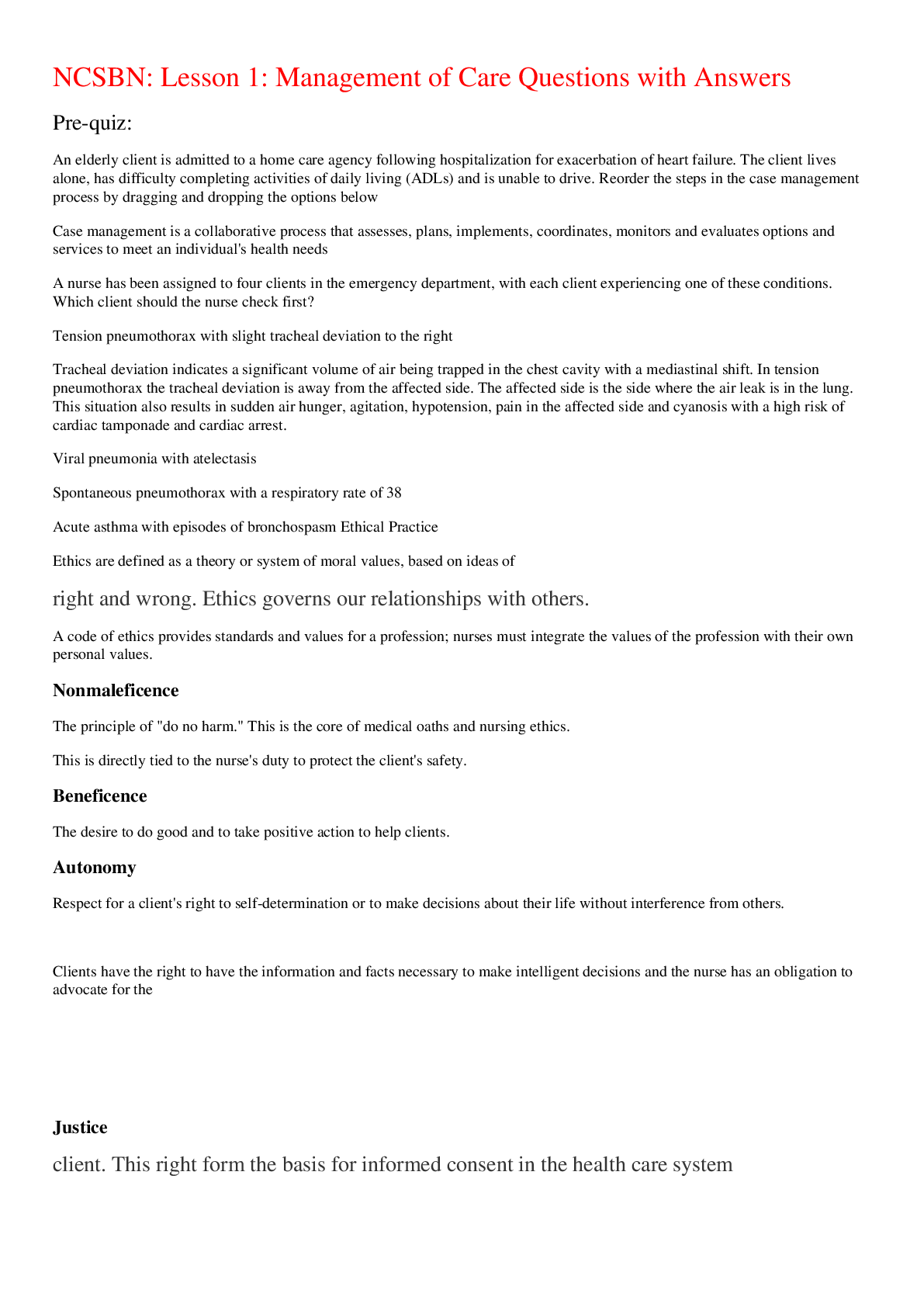
Buy this document to get the full access instantly
Instant Download Access after purchase
Add to cartInstant download
Reviews( 0 )
Document information
Connected school, study & course
About the document
Uploaded On
Jun 15, 2023
Number of pages
14
Written in
Additional information
This document has been written for:
Uploaded
Jun 15, 2023
Downloads
0
Views
40













